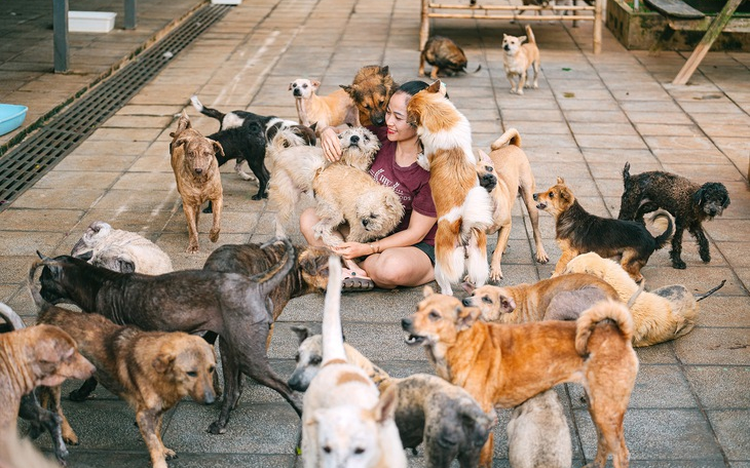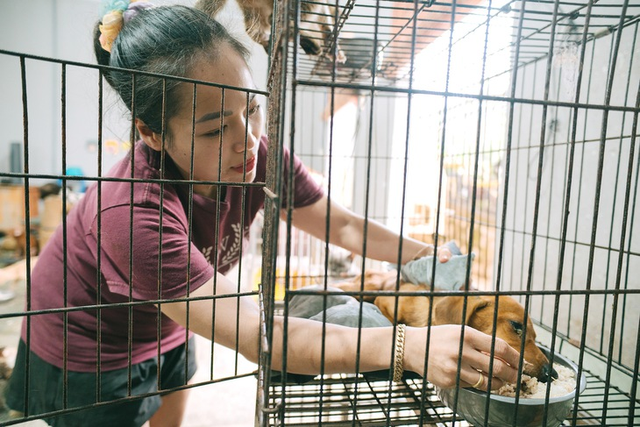
Tran Uyen Nhu shelters abandoned pets. Photo: Thanh Hiep / Tuoi Tre
The Saigontime animal rescue center currently cares for over 800 animals, including dogs, cats, rabbits, turtles, chickens, ducks, and hedgehogs, all rescued from various places.
Dogs and cats make up more than half of the shelter's population, so Nhu, from Ho Chi Minh City, has dedicated two separate rooms to them.
These rooms are cleaned and disinfected daily to maintain hygiene and reduce odors.
Despite the large number of animals, Nhu remembers every single one of their names.
When complimented on this, she often jokes, "Of course I remember! I named them so I can scold them more easily."
If not calling them by name, she tenderly refers to them as 'child,' 'baby,' or 'little one.'
Every day at 4:00 pm, Huynh Ngoc Diep, 29, who has been working at the center for six years, brings trays of food to the dog room.
As soon as she appears, the dogs excitedly bark in anticipation of mealtimes.
Diep, who also serves as the center’s cook, prepares customized meals for the cats beforehand.
To better understand the needs of the animals, Nhu has experimented on herself — once wearing a thick fur coat in the rain to feel what it is like for a dog, or lying directly on the ground to learn how to make their sleep more comfortable.
Based on these experiences, she added plastic pallets and blankets to their bedding for warmth and comfort.
Nhu also personally takes care of the animals after they pass. She has designated a special area at the center for cremation, ensuring they are honored even in death.
Beyond animals, Nhu also rescues succulents and stuffed animals. She built a display room on the shelter’s rooftop to house the stuffed toys she finds abandoned on the street.
Each one is cleaned and given a special spot.
Another section is dedicated to rehabilitating succulents that were improperly cared for, a hobby and passion rooted in her childhood love for nature.
Her journey began in 2014 when she learned of the shelter through the case of a severely injured dog.
Wanting to adopt, she visited in person but, seeing the shortage of caretakers, volunteered to work at the shelter.
Nine months later, the other members left, and at just 23 years old, Nhu took over the shelter.

Tran Uyen Nhu cares for Lap Lap, a puppy suffering from a condition that causes seizures and tremors. Photo: Thanh Hiep / Tuoi Tre
Originally focusing only on dogs and cats, she gradually accepted other abandoned species she came across.
To care for them properly, she taught herself how to treat common illnesses in various animals, and further studied nutrition, behavior, and psychology to quickly recognize any abnormalities.
Before settling in Lam Dong Province, the shelter had relocated through ten different houses in Ho Chi Minh City, often facing complaints and insults.
But these hardships only strengthened Nhu’s resolve to find a permanent home for her animals.
In June 2024, her dream came true with the inauguration of a 2,700-square-meter facility in Lam Dong.
The move was challenging: transporting 230 dogs and 200 cats over 10 hours required strict compliance with health and quarantine regulations.
Running the shelter requires significant monthly expenses, not including emergency medical cases.
To sustain the operation, Nhu and her family run a pet shop and small business, occasionally organizing fundraising campaigns when needed.
She is not alone on this journey. The community continues to support the animals.
One parent, aiming to teach their child about saving, encouraged monthly donations. Since the age of three, the child has contributed VND10,000 (US$0.4) each month with a note: “I want the animals to have a happy day and be full.” Now six, the child still gives.
Watching the animals play and sleep peacefully through the shelter’s surveillance cameras, Nhu feels reassured that her work is meaningful.
These once-abandoned and wounded animals now live surrounded by unconditional care and love.
Though the main shelter is now in Lam Dong, a facility in Ho Chi Minh City is still in operation, located at her parents' home, where rescue efforts primarily take place.
This facility focuses on treatment and recovery, and once the animals are healthy, they are transferred to Lam Dong.


Max: 1500 characters
There are no comments yet. Be the first to comment.